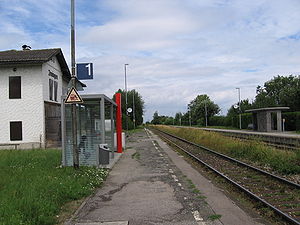
Augsburg-Inningen
Encyclopedia

Augsburg
Augsburg is a city in the south-west of Bavaria, Germany. It is a university town and home of the Regierungsbezirk Schwaben and the Bezirk Schwaben. Augsburg is an urban district and home to the institutions of the Landkreis Augsburg. It is, as of 2008, the third-largest city in Bavaria with a...
, Bavaria
Bavaria
Bavaria, formally the Free State of Bavaria is a state of Germany, located in the southeast of Germany. With an area of , it is the largest state by area, forming almost 20% of the total land area of Germany...
, Germany
Germany
Germany , officially the Federal Republic of Germany , is a federal parliamentary republic in Europe. The country consists of 16 states while the capital and largest city is Berlin. Germany covers an area of 357,021 km2 and has a largely temperate seasonal climate...
. It consists solely of the 41st Stadtbezirk (English: Ward or City Ward), with which it shares a name and is coterminous. As of January 1, 2006, Inningen was reported to have a population 4,735, and an area of 13.42 km2 (5.18 km2). Its population density is 352.8 persons per square kilometer (918.1 persons per square mile). It was previously its own municipality before being annexed to Augsburg in 1972.
History
Although supposedly founded by the Allemanni tribes in the year 506, the town was first mentioned in a historical context in 1071. At that time the town had already been settled by local inhabitants and a Roman roadRoman road
The Roman roads were a vital part of the development of the Roman state, from about 500 BC through the expansion during the Roman Republic and the Roman Empire. Roman roads enabled the Romans to move armies and trade goods and to communicate. The Roman road system spanned more than 400,000 km...
. connecting Augsburg with Kempten im Allgäu
Kempten im Allgäu
Kempten is the largest town in Allgäu, a region in the south-west of Bavaria, Germany. The population was ca 61,000 in 2006. The area was possibly settled originally by Celts, but was later overtaken by the Romans, who called the town Cambodunum...
, ran through the town. The town also has a large millstone
Millstone
Millstones or mill stones are used in windmills and watermills, including tide mills, for grinding wheat or other grains.The type of stone most suitable for making millstones is a siliceous rock called burrstone , an open-textured, porous but tough, fine-grained sandstone, or a silicified,...
also dating from Roman
Roman Empire
The Roman Empire was the post-Republican period of the ancient Roman civilization, characterised by an autocratic form of government and large territorial holdings in Europe and around the Mediterranean....
times. The largest landmark in the area, the Church of Saints Peter
Saint Peter
Saint Peter or Simon Peter was an early Christian leader, who is featured prominently in the New Testament Gospels and the Acts of the Apostles. The son of John or of Jonah and from the village of Bethsaida in the province of Galilee, his brother Andrew was also an apostle...
and Paul was built in 1713. Up until the Second World War
World War II
World War II, or the Second World War , was a global conflict lasting from 1939 to 1945, involving most of the world's nations—including all of the great powers—eventually forming two opposing military alliances: the Allies and the Axis...
, Inningen was a small farming community on the outskirts of Augsburg, although since then it has developed into a more heavily populated residential area of Augsburg. The city lost its status as an independent municipality in 1972. Inningen was, for one day, annexed to Augsburg attached with the neighboring town, Bergheim in order to qualify for a bus depot, and other such amenities, but this was against nearly every local law and was quickly overturned. Inningen and Bergheim are today separate Planungsräume.

